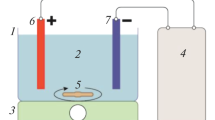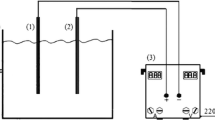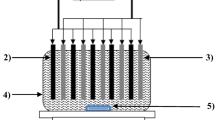Abstract
Electrocoagulation process is an electrochemical method to remove variety of contaminants (i.e., pesticides) from water and wastewater effluents. The current research examines the elimination of propiconazole by electrocoagulation technique. For this aim, after the preliminary screening tests (using factorial design) for the identification of the significant and remarkable factors, response surface methodology based on central composite design is employed to develop a correlative model for the efficiency of the electrocoagulation process. Furthermore, simultaneous optimization of the operational process variables [electrolysis duration (10–60 min), propiconazole initial concentration (10–50 mg/L), current density (2.5–12.5 mA/cm2), and solution conductivity (0.5–2.5 mS/cm)], is carried out to find the most appropriate strategy. The screening of the prime considered factors indicates that pH is not a significant variable and consequently is excluded from further deliberations. A quadratic correlative model is prepared, and model-based optimization is further performed and experimentally verified. The maximum removal efficiency (79.83%) is attained regarding the following process factors: the propiconazole initial concentration of 25.93 mg/L, the time duration of 36.44 min, the current density of 10.95 mA/cm2, and the solution conductivity of 2.44 mS/cm. The results demonstrate that through electrocoagulation process with proper operational variables, the amounts of propiconazole in wastewater effluents can adequately get lowered to acceptable levels.






Similar content being viewed by others
References
Abbasi M, Habibi MM (2016) Optimization and characterization of direct blue 71 removal using nanocomposite of chitosan-mwcnts: central composite design modeling. J Taiwan Inst Chem Eng 62:112–121
Abdul-Wahab S, Abdo J (2007) Optimization of multistage flash desalination process by using a two-level factorial design. Appl Therm Eng 27(2):413–421
Aber S, Amani-Ghadim AR, Mirzajani V (2009) Removal of cr(vi) from polluted solutions by electrocoagulation: modeling of experimental results using artificial neural network. J Hazard Mater 171(1–3):484–490
Adam O, Bitschené M, Torri G, De Giorgi F, Badot P-M, Crini G (2005) Studies on adsorption of propiconazole on modified carbons. Sep Purif Technol 46(1):11–18
Akbal F, Camcı S (2011) Copper, chromium and nickel removal from metal plating wastewater by electrocoagulation. Desalination 269(1):214–222
Ali PI (2012) Environmental water: advances in treatment remediation and recycling. Newnes, Oxford
Ali PI, Gupta VK. Ali I (2002) Adsorbents for water treatment: low cost alternatives to carbon, encyclopaedia of surface and colloid science, (edited by arthur hubbard), vol. 1, Marcel Dekker, New York, pp. 136–166
Ali I, Jain CK (2004) Advances in arsenic speciation techniques. Int J Environ Anal Chem 84(12):947–964
Ali I, Aboul-Enein HY, Gupta VK (2009) Nanochromatography and nanocapillary electrophoresis: pharmaceutical and environmental analyses. Wiley, Hoboken
Ali I, Gupta VK, Khan TA, Asim M (2012a) Removal of arsenate from aqueous solution by electro-coagulation method using al-fe electrodes. Int J Electrochem Sci 7:1898–1907
Ali I, Khan TA, Asim M (2012b) Removal of arsenate from groundwater by electrocoagulation method. Environ Sci Pollut Res 19(5):1668–1676
Ali I, Al-Othman ZA, Alwarthan A, Asim M, Khan TA (2014) Removal of arsenic species from water by batch and column operations on bagasse fly ash. Environ Sci Pollut Res 21(5):3218–3229
Ali I, Alothman ZA, Sanagi MM (2015) Green synthesis of iron nano-impregnated adsorbent for fast removal of fluoride from water. J Mol Liq 211:457–465
Ali I, Al-Othman ZA, Al-Warthan A (2016a) Removal of secbumeton herbicide from water on composite nanoadsorbent. Desalin Water Treat 57(22):10409–10421
Ali I, Al-Othman ZA, Alharbi OM (2016b) Uptake of pantoprazole drug residue from water using novel synthesized composite iron nano adsorbent. J Mol Liq 218:465–472
Ali I, AL-Othman ZA, Alwarthan A (2016c) Green synthesis of functionalized iron nano particles and molecular liquid phase adsorption of ametryn from water. J Mol Liq 221:1168–1174
Ali I, AL-Othman ZA, Alwarthan A (2016d) Molecular uptake of congo red dye from water on iron composite nano particles. J Mol Liq 224:171–176
Ali I, AL-Othman ZA, Alwarthan A (2016e) Synthesis of composite iron nano adsorbent and removal of ibuprofen drug residue from water. J Mol Liq 219:858–864
Ali I, AL-Othman ZA, Alwarthan A (2016f) Sorption, kinetics and thermodynamics studies of atrazine herbicide removal from water using iron nano-composite material. Int Environ Sci Technol 13(2):733–742
Ali I, Alothman ZA, Alwarthan A (2017a) Supra molecular mechanism of the removal of 17-β-estradiol endocrine disturbing pollutant from water on functionalized iron nano particles. J Mol Liq 241:123–129
Ali I, Alothman ZA, Alwarthan A (2017b) Uptake of propranolol on ionic liquid iron nanocomposite adsorbent: kinetic, thermodynamics and mechanism of adsorption. J Mol Liq 236:205–213
Ali I, Alharbi OM, Alothman ZA, Badjah AY, Alwarthan A (2018) Artificial neural network modelling of amido black dye sorption on iron composite nano material: kinetics and thermodynamics studies. J Mol Liq 250:1–8
Amooey AA, Ghasemi S, Mirsoleimani-azizi SM, Gholaminezhad Z, Chaichi MJ (2014) Removal of diazinon from aqueous solution by electrocoagulation process using aluminum electrodes. Korean J Chem Eng 31(6):1016–1020
Antony J (2004) Some pros and cons of six sigma: an academic perspective. TQM Mag 16(4):303–306
Arsand DR, Kümmerer K, Martins AF (2013) Removal of dexamethasone from aqueous solution and hospital wastewater by electrocoagulation. Sci Total Environ 443:351–357
Asfaram A, Ghaedi M, Hajati S, Rezaeinejad M, Goudarzi A, Purkait MK (2015) Rapid removal of auramine-o and methylene blue by zns: Cu nanoparticles loaded on activated carbon: a response surface methodology approach. J Taiwan Inst Chem Eng 53:80–91
Bhatti MS, Kapoor D, Kalia RK, Reddy AS, Thukral AK (2011) Rsm and ann modeling for electrocoagulation of copper from simulated wastewater: multi objective optimization using genetic algorithm approach. Desalination 274(1–3):74–80
Brasil JL, Martins LC, Ev RR, Dupont J, Dias SL, Sales JA, Airoldi C, Lima ÉC (2005) Factorial design for optimization of flow-injection preconcentration procedure for copper (ii) determination in natural waters, using 2-aminomethylpyridine grafted silica gel as adsorbent and spectrophotometric detection. Int J Environ Anal Chem 85(7):475–491
Chen G (2004) Electrochemical technologies in wastewater treatment. Sep Purif Technol 38(1):11–41
Chen P-J, Moore T, Nesnow S (2008) Cytotoxic effects of propiconazole and its metabolites in mouse and human hepatoma cells and primary mouse hepatocytes. Toxicol In Vitro 22(6):1476–1483
Chianeh FN, Parsa JB (2016) Electrochemical degradation of metronidazole from aqueous solutions using stainless steel anode coated with sno 2 nanoparticles: experimental design. J Taiwan Inst Chem Eng 59:424–432
Cobas M, Meijide J, Sanromán M, Pazos M (2016) Chestnut shells to mitigate pesticide contamination. J Taiwan Inst Chem Eng 61:166–173
Colombo R, Ferreira TCR, Ferreira RA, Lanza MRV (2016) Removal of mefenamic acid from aqueous solutions by oxidative process: optimization through experimental design and hplc/uv analysis. J Environ Manag 167:206–213
Czitrom V (1999) One-factor-at-a-time versus designed experiments. Am Stat 53(2):126–131
Daneshvar N, Aber S, Khani A, Khataee A (2007) Study of imidaclopride removal from aqueous solution by adsorption onto granular activated carbon using an on-line spectrophotometric analysis system. J Hazard Mater 144(1):47–51
Dehghani MH, Sanaei D, Ali I, Bhatnagar A (2016) Removal of chromium (vi) from aqueous solution using treated waste newspaper as a low-cost adsorbent: kinetic modeling and isotherm studies. J Mol Liq 215:671–679
Dil EA, Ghaedi M, Ghaedi A, Asfaram A, Jamshidi M, Purkait MK (2016) Application of artificial neural network and response surface methodology for the removal of crystal violet by zinc oxide nanorods loaded on activate carbon: kinetics and equilibrium study. J Taiwan Inst Chem Eng 59:210–220
Esfandian H, Samadi-Maybodi A, Parvini M, Khoshandam B (2016) Development of a novel method for the removal of diazinon pesticide from aqueous solution and modeling by artificial neural networks (ann). J Ind Eng Chem 35:295–308
Fu F, Wang Q (2011) Removal of heavy metal ions from wastewaters: a review. J Environ Manag 92(3):407–418
Gengec E, Kobya M, Demirbas E, Akyol A, Oktor K (2012) Optimization of baker’s yeast wastewater using response surface methodology by electrocoagulation. Desalination 286:200–209
Gottipati R, Mishra S (2010) Process optimization of adsorption of cr (vi) on activated carbons prepared from plant precursors by a two-level full factorial design. Chem Eng J 160(1):99–107
Grady CL Jr, Daigger GT, Love NG, Filipe CD (2011) Biological wastewater treatment. CRC Press, Boca Raton
Guzmán A, Nava JL, Coreño O, Rodríguez I, Gutiérrez S (2016) Arsenic and fluoride removal from groundwater by electrocoagulation using a continuous filter-press reactor. Chemosphere 144:2113–2120
Heidmann I, Calmano W (2008) Removal of zn (ii), cu (ii), ni (ii), ag (i) and cr (vi) present in aqueous solutions by aluminium electrocoagulation. J Hazard Mater 152(3):934–941
Hench KR, Bissonnette GK, Sexstone AJ, Coleman JG, Garbutt K, Skousen JG (2003) Fate of physical, chemical, and microbial contaminants in domestic wastewater following treatment by small constructed wetlands. Water Res 37(4):921–927
Hu CY, Lo SL, Kuan WH (2007) Simulation the kinetics of fluoride removal by electrocoagulation (ec) process using aluminum electrodes. J Hazard Mater 145(1–2):180–185
Imran A, Aboul-Enein H (2006) Instrumental methods in metal ions speciation: chromatography, capillary electrophoresis and electrochemistry, vol 6. Taylor & Francis Ltd, New York, pp 213–220
Jonidi-Jafari A, Shirzad-Siboni M, Yang J-K, Naimi-Joubani M, Farrokhi M (2015) Photocatalytic degradation of diazinon with illuminated ZnO–TiO2 composite. J Taiwan Inst Chem Eng 50:100–107
Karbassi A, Marefat A (2017) The impact of increased oxygen conditions on heavy metal flocculation in the sefidrud estuary. Mar Pollut Bull 121(1–2):168–175
Kobya M, Can OT, Bayramoglu M (2003) Treatment of textile wastewaters by electrocoagulation using iron and aluminum electrodes. J Hazard Mater 100(1–3):163–178
Kurniawan TA, Chan GY, Lo W-H, Babel S (2006) Physico–chemical treatment techniques for wastewater laden with heavy metals. Chem Eng J 118(1):83–98
Lakshmipathiraj P, Raju GB, Basariya MR, Parvathy S, Prabhakar S (2008) Removal of cr (vi) by electrochemical reduction. Sep Purif Technol 60(1):96–102
Liu Z-H, Kanjo Y, Mizutani S (2009) Removal mechanisms for endocrine disrupting compounds (edcs) in wastewater treatment—physical means, biodegradation, and chemical advanced oxidation: a review. Sci Total Environ 407(2):731–748
Miller JN, Miller JC (2010) Statistics and chemometrics for analytical chemistry. Prentice Hall, Upper Saddle River
Mirsoleimani-azizi SM, Amooey AA, Ghasemi S, Salkhordeh-panbechouleh S (2015) Modeling the removal of endosulfan from aqueous solution by electrocoagulation process using artificial neural network (ann). Ind Eng Chem Res 54(40):9844–9849
Montgomery DC (2008) Design and analysis of experiments. Wiley, Hoboken
Montgomery DC (2012) Design and analysis of experiments, 8th edn. Wiley, Hoboken
Mores R, Treichel H, Zakrzevski CA, Kunz A, Steffens J, Dallago RM (2016) Remove of phosphorous and turbidity of swine wastewater using electrocoagulation under continuous flow. Sep Purif Technol 171:112–117
Naje AS, Chelliapan S, Zakaria Z, Abbas SA (2016) Electrocoagulation using a rotated anode: a novel reactor design for textile wastewater treatment. J Environ Manage 176:34–44
Oller I, Malato S, Sánchez-Pérez J (2011) Combination of advanced oxidation processes and biological treatments for wastewater decontamination—a review. Sci Total Environ 409(20):4141–4166
Pérez LS, Rodriguez OM, Reyna S, Sánchez-Salas JL, Lozada JD, Quiroz MA, Bandala ER (2016) Oil refinery wastewater treatment using coupled electrocoagulation and fixed film biological processes. Phys Chem Earth, Parts A/B/C 91:53–60
Robinson T, McMullan G, Marchant R, Nigam P (2001) Remediation of dyes in textile effluent: a critical review on current treatment technologies with a proposed alternative. Bioresour Technol 77(3):247–255
Roosta M, Ghaedi M, Daneshfar A, Sahraei R, Asghari A (2014) Optimization of the ultrasonic assisted removal of methylene blue by gold nanoparticles loaded on activated carbon using experimental design methodology. Ultrason Sonochem 21(1):242–252
Sadeghi S, Rad FA, Moghaddam AZ (2014) A highly selective sorbent for removal of cr (vi) from aqueous solutions based on Fe3O4/poly (methyl methacrylate) grafted tragacanth gum nanocomposite: optimization by experimental design. Mater Sci Eng C 45:136–145
Shafaei A, Rezaie M, Nikazar M (2011) Evaluation of Mn2+ and Co2+ removal by electrocoagulation: a case study. Chem Eng Process 50(11–12):1115–1121
Shah M, Pathak K (2010) Development and statistical optimization of solid lipid nanoparticles of simvastatin by using 23 full-factorial design. AAPS Pharm Sci Tech 11(2):489–496
Sharma S, Imran A (2011) Adsorption of rhodamine b dye from aqueous solution onto acid activated mango (magnifera indica) leaf powder: equilibrium, kinetic and thermodynamic studies. J Toxicol Environ Health Sci 3(10):286–297
Singh JP (2010) United nations educational, scientific, and cultural organization (unesco): creating norms for a complex world. Routledge, Abington
Suárez-Escobar A, Pataquiva-Mateus A, López-Vasquez A (2016) Electrocoagulation—photocatalytic process for the treatment of lithographic wastewater. Optimization using response surface methodology (rsm) and kinetic study. Catal Today 266:120–125
Ternes TA, Stüber J, Herrmann N, McDowell D, Ried A, Kampmann M, Teiser B (2003) Ozonation: a tool for removal of pharmaceuticals, contrast media and musk fragrances from wastewater? Water Res 37(8):1976–1982
Tu T-Y, Hong C-Y, Sasado T, Kashiwada S, Chen P-J (2016) Early life exposure to a rodent carcinogen propiconazole fungicide induces oxidative stress and hepatocarcinogenesis in medaka fish. Aquat Toxicol 170:52–61
Uğurlu M, Gürses A, Doğar Ç, Yalçın M (2008) The removal of lignin and phenol from paper mill effluents by electrocoagulation. J Environ Manage 87(3):420–428
Vialaton D, Pilichowski J-F, Baglio D, Paya-Perez A, Larsen B, Richard C (2001) Phototransformation of propiconazole in aqueous media. J Agric Food Chem 49(11):5377–5382
Wu Q, Riise G, Kretzschmar R (2003) Size distribution of organic matter and associated propiconazole in agricultural runoff material. J Environ Qual 32(6):2200–2206
Zhang J, Guo J, Wu Y, Lan Y, Li Y (2017) Efficient activation of ozone by zero-valent copper for the degradation of aniline in aqueous solution. J Taiwan Inst Chem Eng 81:335–342
Acknowledgements
The authors wish to thank all who assisted in conducting this work.
Author information
Authors and Affiliations
Corresponding author
Additional information
Editorial responsibility: Q. Aguilar-Virgen.
Rights and permissions
About this article
Cite this article
Shadmehr, J., Mirsoleimani-azizi, S.M., Zeinali, S. et al. Electrocoagulation process for propiconazole elimination from wastewater: experimental design for correlative modeling and optimization. Int. J. Environ. Sci. Technol. 16, 5409–5420 (2019). https://doi.org/10.1007/s13762-018-1891-8
Received:
Revised:
Accepted:
Published:
Issue Date:
DOI: https://doi.org/10.1007/s13762-018-1891-8




